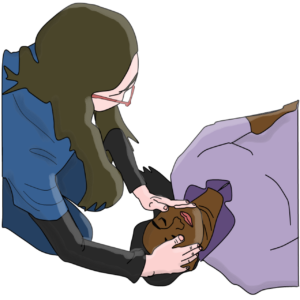Lupus: Widespread Yet Widely Unknown
05/07/2016You’ve probably never heard of it but it’s one of the most pervasive and painful auto-immune diseases that exists.
It is believed that 5 million people throughout the world have a form of lupus, yet many people had never heard about it until it hit close to home.
There are about 4,280 cases per 100,000 population and the highest prevalence is among Afro-Caribbeans.
Although the disease affects members of all races and nationalities, blacks have a worse prognosis, due in large part to the increased prevalence of  renal diseas
renal diseas
e (kidney disease).
Lupus is much more common than leukemia, cystic fibrosis, multiple sclerosis, muscular dystrophy, pernicious anemia, rheumatic fever or Hodgkin’s disease. Yet, only 15% of newly diagnosed lupus patients had even ever heard of lupus.
It is a gravely misunderstood and misdiagnosed disease. Even the name and symbol is confusing. Although lupus got its name from the wolf, it is symbolized by a butterfly. The other trademark of lupus is a purple ribbon.
Demographic of Lupus Sufferers
Lupus by Gender
- 90 percent of the Lupus population are women.
- Men develop lupus too but women are 13 times more likely to develop lupus than men do.
- The disease usually strikes women of childbearing age. 70% have an onset of the illness between ages 13 and 40 years, but anyone at any age can develop lupus.
- Although most women get lupus when their estrogen levels are high, a number of women get lupus after menopause, when estrogen levels are low.
- Lupus can strike children and the elderly, but the symptoms are usually mild.
Lupus by Race
- People of all races and ethnic groups can develop lupus but women of color are three to four times more likely to develop lupus than Caucasians.
- Asian, and Native American descent are also more likely to develop lupus than Caucasians.
- African-American women suffer from more severe symptoms and have a higher mortality rate.
Lupus, Genetics & Lifestyle
- 20 percent of people with lupus will have a parent or sibling who already has lupus or may develop lupus.
- About 5 percent of the children born to individuals with lupus will develop the illness.
- Those who have a family history of lupus are 5 percent more likely to develop the disease than the general population, but only about 10% of people with lupus have a close relative with the disease.
- Other factors that trigger the body’s autoimmune attack and potential culprits include cigarette smoke, sunlight, stress, and certain infections.
 So what is this Lupus?
So what is this Lupus?
Lupus is an inflammatory disease where the immune system attacks its own tissues causing one to feel ill. The function of the immune system is to protect the body from infection but when one has lupus the ability to ward off infection is impaired and the body instead of protecting itself from bacteria and viruses, attacks its own body tissues.
Lupus is a chronic disease which means the symptoms last longer than six weeks and often for many years.
The latin word for lupus is wolf and it attacks virtually every organ in the body – the skin, joints, kidneys, brain, heart, lungs and blood.
Lupus is a disease of flares and remissions. One minute the symptoms worsen (or the wolf awakens) and sufferers feel ill, the next minute the symptoms improve and they feel better.
Lupus can range from mild to life-threatening and should always be treated by a doctor. With good medical care, most people with lupus can lead a full life.
Lupus rears its ugly head in three forms:
-
Cutaneous Lupus
-
Systemic Lupus Erythematasos (SLE)
-
Drug Induced
Cutaneous Lupus
Cutaneous lupus affects the skin. And the most common type of skin Lupus is Discoid Lupus Erythematosus (DLE).
Discoid Lupus accounts for about 10 percent of all lupus cases according to data from the Lupus Research Institute. This type of Lupus generally affects only the skin. Such skin problems are large red, circular rashes that may scar. Sores typically appear on the face and scalp but can affect the skin anywhere on the body. Discoid Lupus sufferers are sensitive to ultraviolet light, and should stay out of the sun as sunlight aggravates these rashes.
The two types of rashes are:
- Subacute cutaneous lupus erythematosus which mostly affects the arms, legs, and torso.The rash often worsens after exposure to the sun.
- “Bullous” lupus rash – this one is uncommon but is a serious form of lupus rash. Upon sun exposure large blisters may occur.
Some sufferers may also experience hair loss. Ten percent of people with Discoid Lupus will go on to develop Systemic Lupus, the more severe form of the disease.
Systemic Lupus SLE
 Systemic Lupus affects both the skin and/or internal organs. It is the more common form of lupus and accounts for 70 percent of all lupus cases. In almost half of these cases, a major organ will be affected. Among them:
Systemic Lupus affects both the skin and/or internal organs. It is the more common form of lupus and accounts for 70 percent of all lupus cases. In almost half of these cases, a major organ will be affected. Among them:
Kidney – Half of all Lupus sufferers kidneys can get affected and can be life-threatening. Kidney problems are more common in victims with symptoms of fatigue, arthritis, rash, fever, and weight loss.
Heart and Lungs – Inflammation is the root cause of heart and lung involvement in lupus sufferers. Patients may experience chest pain, irregular heartbeat, and accumulation of fluid around the lungs (pleuritis or pleurisy) and heart (pericarditis). Shortness of breath when the heart valves and the lung itself become affected may also occur.
Blood – People with lupus may have dangerous reductions in the number of red blood cells or anemia, white blood cells that may cause serious infection, or platelets – particles that help clot the blood – or easy bruising or bleeding. Because many patients do not have symptoms from low blood counts, it is important for people with lupus to have periodic blood tests in order to detect any problems.
People with Lupus are also more prone to clotting of the blood. Clots often occur in the legs called deep venous thrombosis or DVT) and lungs (called pulmonary embolus or PE) and occasionally in the brain (stroke).
Skin – Skin problems are a common feature of lupus. Some people have a red rash over their cheeks and the bridge of their nose – called a “butterfly” or malar rash.
Brain and Spinal Chord. Brain involvement is a rare problem in people with lupus. But when present, it may cause confusion, depression, seizures, and, rarely, strokes. Involvement of the spinal cord (transverse myelitis) can cause numbness and weakness.
Hair loss and mouth sores are also common.
Drug-induced Lupus
Drug-induced Lupus accounts for about 10 percent of all lupus cases and is caused by high doses of certain medications like hydralazine usually taken for High Blood Pressure or congestive heart failure and procainamide an antiarrythmic usually taken to treat heart problems can cause lupus. The symptoms of drug-induced lupus are similar to systemic lupus; however, symptoms usually subside when the medications are discontinued.
 But lupus –the Great Imitator – isn’t easy to diagnose
But lupus –the Great Imitator – isn’t easy to diagnose
Lupus is not a one size fits all kind of disease. It affects each person differently, has no known cause or cure. The reports say there is a genetic predisposition but the cause is still a mystery.
Lupus mimics other autoimmune diseases and is therefore regarded as the great imitator. Because its symptoms imitate other illnesses like rheumatoid arthritis, blood disorders, fibromyalgia, diabetes, thyroid problems, Lyme disease, and a number of heart, lung, muscle, and bone diseases, lupus is very difficult to diagnose, hard to live with and a challenge to treat. Depending on the type of lupus, it can take up to 8 years for a diagnosis.
There is no one test for diagnosing lupus. After careful examination or blood test abnormalities if several features of the disease are present, you may get diagnosed. To assist doctors in correctly diagnosing lupus, the American College of Rheumatology says a person should have at least four of the criteria, either at the same time or one after the other, to be classified as having lupus.
The most common symptoms of Lupus are the same for both females and males:
- Extreme fatigue (tiredness)
- Headaches
- Painful or swollen joints
- Ankle swelling and fluid accumulation
- Fever more than 100F
- Anemia (low numbers of red blood cells or hemoglobin, or low total blood volume)
- Swelling (edema) in feet, legs, hands, and/or around eyes
- Pain in chest on deep breathing (pleurisy)
- Skin rash/Malar rash butterfly rash that appears around the cheek and nose
- Sun- or light-sensitivity (photosensitivity)
- Hair loss
- Abnormal blood clotting
- Fingers turning white and/or blue when cold (Raynaud’s phenomenon)
- Mouth or nose sores
- Kidney disorders – either excess protein in the urine (proteinuria) or red blood cells in the urine
- Neurological Disorder – seizures or psychosis (a severe mental disorder in which thought and emotions are so impaired that contact is lost with external reality).
- Inflammation of the lining around the lungs (pleuritis) or of the lining around the heart (pericarditis)
- Depression and Anxiety
- Memory loss
- Shortness of breath
See your doctor if you develop any unexplained rashes, have ongoing fevers, persistent aching or fatigue. Although it usually takes 7 to 8 years to diagnose, as with all other medical conditions the sooner you get diagnosed the greater your chances of leading a full life. Conversely, the longer you wait for a diagnosis and treatment especially if you have SLE lupus, the more damage will be done to your body which in the case of Lupus cannot be reversed or repaired.
With SLE, lack of diagnosis can lead to potentially life-threatening complications like kidney failure, heart and cardiovascular disease, lung damage or stroke. Undiagnosed SLE can also raise the risk of pre-eclampsia (a pregnancy complication characterized by high blood pressure and signs of damage to another organs system, often the kidneys), miscarriage, stillbirth and premature birth.
There is no cure for Lupus yet, but it can be treated
A Lupus diagnosis can feel very daunting, uncertain and scary. But with medicines like steroids, immunosuppressants and lifestyle changes the disease can be controlled. While some people with mild features of the disease do not require treatment, others with serious involvement (such as kidney complications) may require powerful medications.
Drugs used to treat lupus include:
- Steroids – used when internal organs are threatened. The creams also used for rashes.
- Plaquenil (hydroxychloroquine) – commonly used to help keep mild lupus-related problems, such as skin and joint disease under control and flares at bay.
- Cytoxan(cyclophosphamide) – a chemotherapy drug effective in reducing the activity of the immune system. It is used to treat severe forms of lupus, such as those affecting the kidneys or brain.
- Imuran (
 azathioprine) – commonly used to treat the more serious features of lupus.
azathioprine) – commonly used to treat the more serious features of lupus. - Rheumatrex (methotrexate) –another chemotherapy drug used to suppress the immune system. Popularly used for skin disease, arthritis, and other non-life-threatening forms of disease. It is also a substitute for medications such as hydroxychloroquine or low doses of prednisone.
- Benlysta (belimumab)– when given in addition to standard drug therapy, people with active, autoantibody-positive lupus may benefit from Benlysta.
- CellCept (mycophenolate mofetil) – a drug that suppresses the immune system. It is also used to prevent rejection of transplanted organs.
- Rituxan (rituximab) – used to treat lymphoma and rheumatoid arthritis. It is used to treat the most serious features of lupus when other therapies are not effective.
Lifestyle changes to improve well-being and quality of life:
- Exercise but don’t overdo it. Walk, swim, bike ride to help prevent muscle wasting and lower your risk for developing osteoporosis.
- Eat nutritious, well-balanced meals
 Avoid alcohol. Alcohol can interact with your medications to cause significant stomach or intestinal problems, including ulcers.
Avoid alcohol. Alcohol can interact with your medications to cause significant stomach or intestinal problems, including ulcers.- Don’t smoke. Smoking can impair circulation .Tobacco smoke also has negative effects on your heart, lungs, and stomach.
- Avoid too much sunexposure. People with lupus may develop rashes or disease flares when exposed to the sun especially between 10 a.m. and 2 p.m., wear sunglasses, a hat, and sunscreen.
- Take care of fevers and infections promptly. A fever may indicate an infection or a lupus flare-up.
- Build an honest and open relationship with your doctor.
- Finding the right medication and dosage that works best for you often takes time so exercise patience.
- Follow your doctor’s treatment plan to a T.
- Don’t be afraid to ask questions.
- Keep a record of your lupus symptoms. Journal which parts of your body are affected and any situations or activities that seem to trigger your symptoms.
Prognosis for People With Lupus?
There is no one size fits all treatment for this cruel, mysterious and troublesome disease. While there may be periods with symptoms, there are some periods where the disease is in remission and devoid of symptoms. If doctors’ instructions are followed and patients stick with their treatment regimen, they can expect to have a normal lifespan. However, it is believed that between 10-15 percent of people with lupus will die prematurely due to complications of lupus.
 Just 25 years ago, only 40 percent of people with lupus were expected to live more than 3 years following the diagnosis. Today, most people with lupus can look forward to a normal lifespan.
Just 25 years ago, only 40 percent of people with lupus were expected to live more than 3 years following the diagnosis. Today, most people with lupus can look forward to a normal lifespan.
Don’t be afraid to recognize when you need help and to ask for it. Consider joining a support group. It often helps to talk to others who are walking in your shoes.
May you be well!
 May is Lupus Awareness Month. This post was written in loving memory of Delisha ‘Nazy’ Victor, a fellow Manmay LaKay who passed away from the complications of lupus on 3/2/15. Here’s her story; her journey with the disease and her demise. May Delisha Joan Nazy Victor continue to rest peacefully.
May is Lupus Awareness Month. This post was written in loving memory of Delisha ‘Nazy’ Victor, a fellow Manmay LaKay who passed away from the complications of lupus on 3/2/15. Here’s her story; her journey with the disease and her demise. May Delisha Joan Nazy Victor continue to rest peacefully.
There are many people living with lupus. Check out Felicia Leon’s incredible Living with Lupus story. A very courageous and inspirational Manmay LaKay, who has mastered the art of coping with this debilitating disease.
Spread the word to help stomp Lupus out and find a cure.





